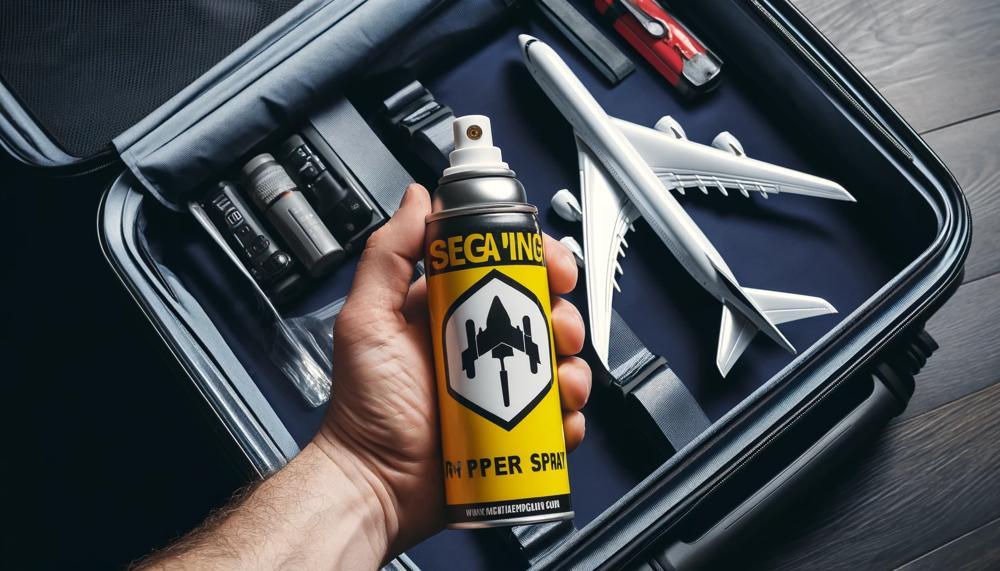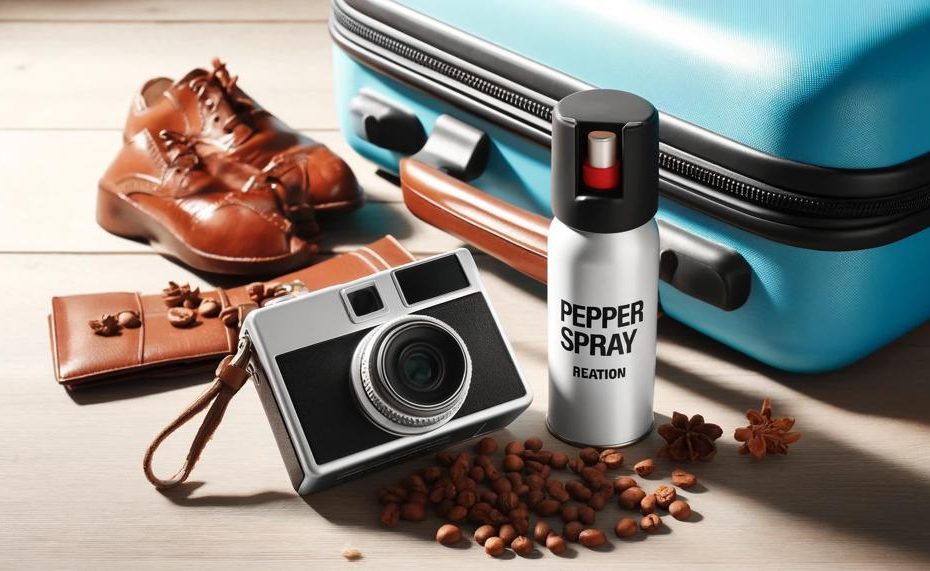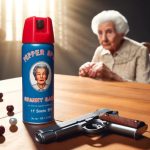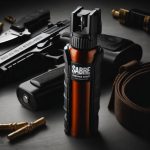Did you know that every year, over 30 million Americans travel internationally? For many, personal safety is a top priority, leading to a common question: “Can I pack pepper spray in my checked luggage?” This topic isn’t just relevant for travelers looking to protect themselves but also crucial for those who want to avoid airport security issues.
In this blog post, we will delve into the nitty-gritty of traveling with pepper spray.
So, can i pack pepper spray in my checked luggage?
Yes, you can pack pepper spray in your checked luggage under certain conditions according to the Transportation Security Administration (TSA)1. Here are the conditions:
- The container must be no larger than 4 fl. oz. (118 ml).
- The container must be equipped with a safety mechanism to prevent accidental discharge.
- Self-defense sprays containing more than 2 percent by mass of tear gas (CS or CN) are prohibited in checked baggage.
However, it’s important to note that some airlines may not allow this item in checked bags1. For example, Delta Air Lines lists pepper spray as a prohibited item. Therefore, it’s recommended to check with your specific airline before packing pepper spray in your checked luggage1. The final decision rests with the TSA officer on whether an item is allowed through the checkpoint.
So, let’s dive in.
Contents
- 1 Can you fly with pepper spray in your carry-on?
- 2 What Size Pepper Spray is Travel Size?
- 3 Can you take pepper spray abroad?
- 4 Is it illegal to carry pepper spray?
- 5 What self-defense weapons can you fly with?
- 6 Each of the major American Airlines answers: ‘Can You Fly With Pepper Spray?’
- 7 Does mace explode on a plane?
- 8 How to Travel with Pepper Spray
- 9 Best Pepper Sprays for Self Defense
- 10 Is it legal to take pepper spray onto an airplane?
- 11 Pepper Spray Regulations and Laws By State 2023
- 12 Conclusion
Can you fly with pepper spray in your carry-on?
No, you cannot bring pepper spray in your carry-on luggage when flying. However, you may carry a small, specifically regulated container of pepper spray in your checked luggage under certain conditions.
| Aspect | Carry-On Luggage | Checked Luggage |
|---|---|---|
| Permissibility | Not allowed under any circumstance | Allowed with restrictions |
| Size Restrictions | N/A | Up to 4 fl. oz. (118 ml) |
| Safety Mechanism | N/A | Must have a safety mechanism to prevent accidental discharge |
| Active Ingredient Limit | N/A | Less than 2% by mass (oleoresin capsicum) |
| Declaration | N/A | Must be declared to the airline |
It’s crucial to remember that these guidelines apply to flights within and into the United States, as governed by the Transportation Security Administration (TSA). Airlines might have their own additional regulations, and laws vary by country.
Always check the latest rules with your airline and the TSA website before travel, and consider the regulations of your destination country.
Packing pepper spray in checked luggage requires careful consideration of containment to prevent leaks and ensuring the container has a safety mechanism to avoid accidental activation.
What Size Pepper Spray is Travel Size?
When you’re jetting off and want to keep a bit of self-defense in your suitcase, it’s crucial to know the TSA’s rules on pepper spray.
| Criteria | Maximum Size | Additional Requirements |
|---|---|---|
| Volume | 4 ounces (118 milliliters) | Container must prevent accidental discharge |
| Weight | 4 fluid ounces | Label must indicate it’s for self-defense |
| Container Integrity | Strong material | Secure lid to avoid leaks or spills |
Remember, mate, even if your pepper spray is a wee bit under 4 ounces but in a bigger canister, it won’t make the cut. Stick to these rules, and you’ll fly through security.
Can you take pepper spray abroad?
Yes, it is generally legal to bring pepper spray in your checked luggage when traveling abroad, but with strict guidelines and notable variances depending on the destination.
The legality hinges on compliance with both the airline’s policies and the laws of the country to which you’re traveling. Here’s a deeper look:
Key Considerations for Packing Pepper Spray
| Aspect | Requirement | Explanation |
| Container Size | 4 fl. oz. (118 ml) or less | Only one container is allowed per passenger in checked bags. |
| Safety Mechanism | Must have | Prevents accidental discharge during transport. |
| Tear Gas Percentage | Less than 2% | Regulated to minimize risks in case of leakage. |
| Labeling | For self-defense | Clarifies the purpose of the item to security and airline staff. |
| Declaration | Varies by country | Some destinations require declaration upon arrival. |
Legal and Airline Policies
- TSA/FAA Rules: While TSA permits a 4 fl. oz. container in checked baggage, always double-check the latest guidelines before flying. TSA does not allow pepper spray in carry-on luggage.
- Airlines’ Stance: Airlines might have their own restrictions. Contact your airline for their specific policy to avoid surprises at the airport.
- Destination Laws: Countries vary widely in their legality and acceptance of pepper spray. Some nations may categorize it as a weapon, leading to potential legal complications upon arrival.
Safe Travel Tips with Pepper Spray
- Check Expiration: Ensure your pepper spray is within its effective date range. Expired products may lose potency or fail to function correctly.
- Secure Packaging: To prevent accidental discharge, pack the pepper spray in a secure container within your checked luggage.
- Research Local Laws: Prior to departure, investigate the legal status of pepper spray in your destination. This step is crucial to avoid unintended legal issues.
- Declaration: If required by your destination, declare the pepper spray upon arrival. Some countries have strict customs regulations and failing to declare could result in penalties.
By adhering to these guidelines and conducting thorough prep, travelers can navigate the complexities of flying with pepper spray.
Is it illegal to carry pepper spray?
Carrying pepper spray isn’t outright illegal, but it’s tangled in a web of specific local and international laws. Before you chuck a canister into your bag, know the rules to avoid legal stings.
In the UK, for instance, pepper spray is classified as a section 5(1)(b) weapon under the Firearms Act 1968, making it a no-go for personal use.
Across the pond in the USA, it’s a different story, with legality varying state by state. Got travel plans? Packing it in checked luggage might fly in some places, but you’re playing with fire if you don’t double-check the destination’s regulations and airline policies.
Air Travel with Pepper Spray
When jet-setting with pepper spray, the FAA throws a curveball – it’s a yes for checked bags but a hard no for carry-ons. Think you’re set for takeoff? Hang on, there’s more. Airlines often have their own playbook, so a pre-travel check-in call is a smart move.
Don’t get blindsided at the airport; ensure your pepper spray’s packaging and contents meet the airline’s criteria.
| Region/Country | Carry-on Bags | Checked Luggage |
| USA | No | Yes, with airline-specific rules |
| Canada | No | No (classified as a prohibited weapon) |
| UK | No | No (considered a firearm) |
Global Shuffle: Pepper Spray Laws Around the World
Globetrotting with your trusty pepper spray? Tread carefully; international waters mean a sea of different laws. Some places might treat it like any other personal safety tool, while others label it as contraband. Research is your best friend here.
Dive into the legal landscape of your destination before packing that spicy aerosol.
Public Transport and Beyond
Planes aren’t the only place where pepper spray laws tighten. Buses, trains, and cruise ships often have their own set of rules. A quick check with customer service can save you from a world of hassle. Remember, legal doesn’t always mean allowed everywhere.
Places like schools, government buildings, or public events might have strict no-pepper-spray policies.
Carrying pepper spray is like holding a double-edged sword – it’s a protective tool that demands respect and awareness of the law.
What self-defense weapons can you fly with?
When you’re hitting the skies and want to keep yourself safe, knowing what self-defense items you can tuck into your checked luggage is key.
Let’s cut straight to the chase, focusing on pepper spray, a popular choice for many travelers seeking a bit of security in their pocket.
Pepper Spray as Self-Defense in the Air
While there are a handful of items you’re allowed to pack in your checked bags, pepper spray stands out for its portability and effectiveness. However, it’s not as simple as tossing it in your bag and heading off.
There are specific guidelines you’ve got to follow to stay on the right side of the law and airline policies.
Key Guidelines for Packing Pepper Spray:

- Quantity Matters: You can pack one pepper spray container per person, but it’s got to be less than 118ml (4 fl. oz.).
- Safety Features: Ensure your pepper spray has a safety mechanism to prevent accidental discharge.
- Pack it Right: It must be in a container that protects it from accidental activation.
Given these points, here’s a handy table to sum up what you need to know about flying with self-defense items, focusing on pepper spray:
| Item | Allowed in Checked Luggage | Specifications |
| Pepper Spray | Yes | One canister per person, less than 118ml (4 fl. oz.), with safety mechanisms |
| Unloaded Firearms | Yes | Must be declared, unloaded, in a locked hard-sided container |
| Tasers | Yes | With restrictions and must be safely packaged |
Remember, while pepper spray can be a comforting item to have, especially in unfamiliar places, it’s paramount to handle it responsibly.
Always check the specific airline and destination regulations before you fly, as these can vary and change.
Each of the major American Airlines answers: ‘Can You Fly With Pepper Spray?’
Righto, let’s cut to the chase about flying with pepper spray and what the big American airlines have to say about it.
We’re talking about those wee cans of self-defence that might just give you peace of mind but can also cause a bit of a kerfuffle if not handled properly.
Regulations and Policies of Major American Airlines on Pepper Spray in Checked Luggage
| Airline | Allowance in Checked Luggage | Specific Conditions |
| American Airlines | Yes, up to 2 canisters | Each canister must not exceed 4 ounces (118 ml). Must have a mechanism to prevent accidental discharge. |
| Delta Airlines | Yes, limited to 1 canister | Canister no larger than 4 ounces (118 ml) with safety features. Declaration at check-in might be required. |
| United Airlines | Yes, with restrictions | Only one pepper spray or mace container, not exceeding 4 ounces (118 ml) and equipped with a safety mechanism. |
| Southwest Airlines | Yes, subject to conditions | Pepper spray up to 4 ounces (118 ml) allowed; must be in checked luggage with safety mechanisms. |
A Bit More on the Fine Print
Alright, now you’ve got the lowdown on what’s what with each airline. But remember, just because you can pack it, doesn’t mean you should forget about it.
Make sure your pepper spray is snug in its container, can’t accidentally go off, and doesn’t weigh more than 4 ounces. You don’t want to be that person who causes a delay because your bag is buzzing in the hold.
Before You Zip That Suitcase
- Check State Laws: Just because the skies are friendly to your pepper spray, doesn’t mean your destination is. Laws can be as varied as the weather, so check ’em before you land in hot water.
- Airline Policies: They can change quicker than British weather. A quick call or a visit to their website will set you straight for your trip.
- Pack it Right: That means in your checked luggage, not in your carry-on or on your person. You don’t want a face-off with TSA over a misunderstanding.
So, there you have it. Each of the major American airlines has their say on the matter, and now you’re in the know.
Does mace explode on a plane?
Answer: The worry about mace going boom on a plane is a bit like fretting over a storm in a teacup. But, let’s not toss caution to the wind. Mace, or pepper spray, is packed with chemicals that can raise eyebrows if not packed right. So, here’s the scoop, straight up: mace itself isn’t prone to exploding due to pressure changes in the aircraft’s cargo hold.
Yet, it’s the aerosol canister that’s the stickler. These containers are under pressure and, if damaged, could let loose, causing a ruckus but not an explosion in the Hollywood sense.
Now, the real meat of the matter isn’t about the potential for pyrotechnics but rather what the folks who make the rules – namely, the TSA and various airlines – say about bringing this spicy self-defence tool on your travels.
| Aspect | Details | Advice |
| Carry-On Bags | A big no-no | Don’t even think about slipping it into your hand luggage. |
| Checked Luggage | Limited to one 4 fl. oz. (118 ml) container | Must have a safety mechanism to prevent accidental discharge. |
| Legalities Abroad | Varies by destination | Check the local laws of your landing spot before flying. |
Remember, while mace won’t go kaboom, packing it requires a bit of know-how. Stick to the rules, keep it in checked luggage if it’s a must-have, and always double-check the expiry date and safety features.
How to Travel with Pepper Spray
When packing pepper spray in checked luggage for travel, it’s crucial to adhere to the guidelines and regulations set by the Transportation Security Administration (TSA) and the Federal Aviation Administration (FAA).
| Aspect | Guideline | Details |
| Safety Mechanism | Required | Must have a cap or cover to prevent accidental discharge. |
| Volume | Max 4 ounces (118 ml) | Exceeding this limit is not permitted. |
| Material | Hard plastic or metal | Glass or ceramic containers are not allowed. |
| Substances | No tear gas | Check the label for prohibited ingredients. |
| Airline Policy | Varies | Always check with the airline before traveling. |
| Destination Laws | Research Required | Understand the legality in the country you are visiting. |
| Declaration | Possible Requirement | Some airlines may ask for pepper spray to be declared at check-in. |
| Packaging | Sealed/Wrapped | To prevent leakage, pack in a sealed bag or wrap in plastic. |
Best Pepper Sprays for Self Defense
| Product Name | Features | TSA Compliant for Checked Luggage |
| Sabre Red Pepper Gel | Jet spray pattern, reduces wind blowback, 18-foot range | Yes, with limitations* |
| Fox Labs Mean Green Pepper Spray | Green dye for suspect identification, 20-foot range, heavy stream pattern | Yes, with limitations* |
| Mace Brand Police Strength Pepper Spray | UV dye for suspect marking, flip-top safety cap, 12-foot range | Yes, with limitations* |
*Limitations refer to the need to follow TSA and FAA guidelines, like ensuring the canister size does not exceed 4 ounces and is equipped with a safety mechanism to prevent accidental discharge.
Is it legal to take pepper spray onto an airplane?
| Legality Overview | Pepper spray is not permitted in hand luggage. | Pepper spray can be carried in checked luggage under specific conditions. |
| TSA Regulations | Limits containers to 4 oz or less. | Safety mechanisms required to prevent accidental discharge. |
| Airline Policies | Some airlines completely prohibit pepper spray, regardless of TSA allowances. | Check specific airline policies before travel. |
Pepper spray, while a popular self-defense tool, faces strict regulations when it comes to air travel. It is generally illegal to carry pepper spray in hand luggage on an airplane. The Transportation Security Administration (TSA) does allow a small container of pepper spray (up to 4 ounces) in checked baggage, but it must have a safety mechanism to prevent accidental discharge.
However, individual airline policies might be stricter than TSA regulations. For example, airlines like Delta and Southwest Airlines explicitly forbid pepper spray on their flights, whether in checked or carry-on luggage. This prohibition is in place despite TSA’s more lenient rules, underscoring the importance of verifying with your airline before packing.
Always double-check the most current guidelines directly with the TSA and consult your airline to confirm their specific rules concerning pepper spray.
Pepper Spray Regulations and Laws By State 2023
Navigating the intricacies of air travel with pepper spray requires a keen understanding of the rules that keep us safe in the skies. In 2023, the guidelines for packing pepper spray in checked luggage for domestic flights within the United States remain clear yet strict, ensuring travelers can protect themselves while adhering to safety protocols.
TSA Guidelines for Pepper Spray in Checked Luggage:
- Quantity Limit: A maximum of one pepper spray container per passenger is permitted.
- Size Restriction: The container must not exceed 4 ounces (118 ml) in volume.
- Safety Features: The spray must be equipped with a safety mechanism to prevent accidental discharge.
- Declaration: Although not always required, it’s wise to declare the item to the airline at the check-in counter.
Airlines’ Stance on Pepper Spray:
It’s vital to remember that while the TSA sets federal guidelines, individual airlines may impose stricter rules. Some carriers may forbid pepper spray altogether, regardless of TSA allowances. Therefore, directly contacting your airline prior to travel is recommended to avoid any last-minute surprises.
International Considerations:
For those journeying beyond the U.S., the legality of pepper spray varies by country. Always verify the destination’s laws and, if permitted, declare the item upon arrival to avoid legal complications.
Practical Advice:
- Always Check: Before packing, confirm the current TSA guidelines and consult with your airline.
- Proof of Regulations: Keep a copy of the TSA regulations handy, either printed or on your phone, to resolve any discrepancies at the airport.
- Alternative Options: Consider non-lethal self-defense alternatives that are less likely to face travel restrictions.
Understanding the Table Below:
This table breaks down the key aspects of the 2023 regulations for packing pepper spray in checked luggage on domestic flights in the U.S.:
| Aspect | Detail | Advice |
| Quantity Allowed | 1 container per passenger | Limit yourself to one; more could lead to confiscation. |
| Maximum Size | 4 ounces (118 ml) | Ensure your spray is within size limits to avoid disposal. |
| Safety Mechanism | Required | Check your spray has a safety lock to prevent accidental use. |
| Airline Policy | Varies | Double-check with your airline; they may have stricter rules. |
Staying informed and prepared makes for a stress-free travel experience, ensuring you can focus on the journey ahead with peace of mind.
Conclusion
When you check your bags and put pepper spray inside, it’s like walking a wire. Balance and being aware are very important. This trip through the rules about carrying pepper spray on an airplane has shown me how to get through the confusing web of laws, safety rules, and company rules. When travelers know about size limits, the need for safety features, and the importance of following both TSA rules and foreign laws, they can safely go on their next journey, knowing they are safe and following the rules.
Different places have different rules, so it’s important to stay vigilant. What’s okay in one place might not be okay in another. This conversation has not only brought to light the most important steps for carrying pepper spray in the US, but it has also shed light on the legalities of traveling abroad, where things are very different. When people get ready to cross countries, they need to understand and accept these small differences more than anything else.
Pepper spray is a great way to protect yourself, but it also makes you think about how hard it is to move these days. By carefully planning ahead and ensuring that packages are the right size, equipped with the right safety features, and packed in accordance with all the rules, travelers can avoid these problems. With this information, travelers can navigate the complicated travel rules like a ship captain through foggy waters, making sure that their safety gear is both legal and effective.
In the end, traveling with pepper spray isn’t just about self-defense; it’s also about traveling with awareness and knowledge. As globetrotters, it’s our duty to not only keep ourselves safe but also follow the rules that guide the places and skies we visit.





